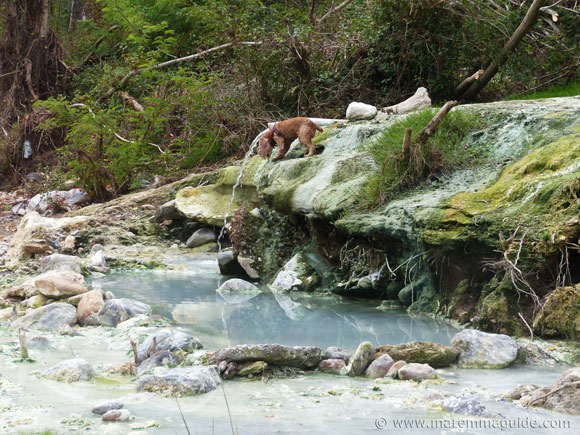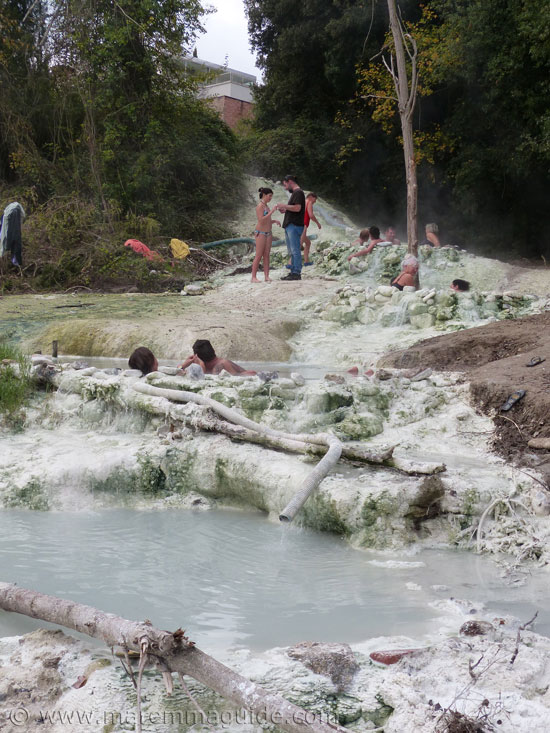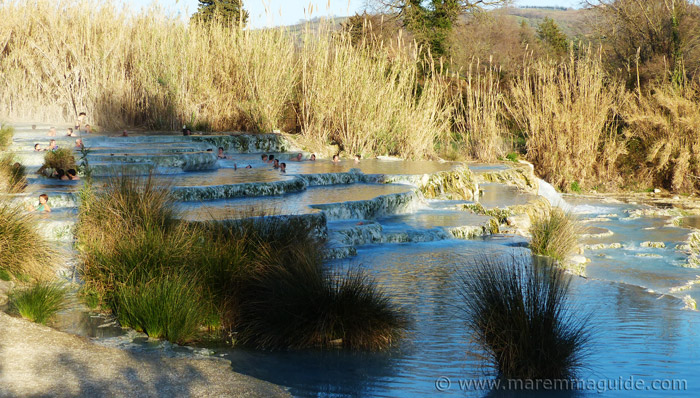Terme di Petriolo hot springs
A Tuscany pearl that has lost its lustre
The Terme di Petriolo hot springs and baths - the natural thermal outdoor and free ones - were once a pearl in Tuscany's treasure chest of special places to visit, but they have lost their lustre. Having wanted to take a dip in their thermal waters - the hottest in Italy - for so very long, I finally made the trip yesterday. But I didn't stay.

It is very rare for me to write negatively about a place. In fact, to date, I have only ever done so once before (and that was about boring Bolgheri).
For no matter how ordinary or potentially uninspiring, aka "boring" - I hasten to use the word, but to explain, I have a young daughter and often take her and her friends out with me exploring Maremma - a place may seem to be at first glance, with no particular things to see, we have always spent time, slow time, there and explored every nook, cranny, and alleyway. And we have always, always, returned home filled with fascination and delighted with what we have discovered. Enough and more to fill a page.
In the case of the Terme di Petriolo thermal springs and baths, my hope in this case is that time - and coordinated care and attention, for that is surely what they are in desperate need of - will give them back their shine.
The nicest way I can put it is that if you have saved money to visit Tuscany and have read about the natural thermal springs and baths at Petriolo, then you will be sorely disappointed if you visit.
Unless you can turn a blind eye to new age traveller camps and "shops", and white tissue trails in the woods to reach them. And then plastic pipes, chairs, and rocks covered in graffiti when you do.
There is an Italian word that sums it up for me: "vergogna". Which means shame/embarrassment. I won't be taking visiting friends and family to see them as they are now.
 The lesser of the FKK graffiti you'll find at the hot baths.
The lesser of the FKK graffiti you'll find at the hot baths.There aren't the gushing streams, torrents of thermal waters, and waterfalls of Saturnia here: all of the bath formations are fed water by plastic pipes. Some dribble, but none gush.

My photographs in this page are the nicer looking of the ones that I took. The puppy in this one kindly covered-up most of the view of the pipe for me.

The view up river.
 The River Farma - Fiume Farma
The River Farma - Fiume FarmaThe view down river.

A little bit of history
The earliest surviving record of Petriolo dates back to the year 1130, and those of the baths to seventy-two years later, in 1202, in the accounts of the then ruling Ardengheschi family of Siena.
But it is known from Etruscan and Roman finds in the area, including tombs, that both civilisations frequented the thermal waters here.
In 1250 spaces in the baths were being rented, the fees for which and the collection of monies managed by the City of Siena. And it was a profitable business, bolstering the finances of the city. So much so that it renovated and regularly maintained the five baths, and several times, each unsuccessfully, sought-out new sources of thermal waters to expand the business.
In 1292, when the only remaining structure of the ancient spa that you can see today with its chapel above was built, there were also four other churches and a hospice in Petriolo.
Today the church is at risk of collapse and the walls of the Renaissance baths have already started to. The area is cordoned-off and it is no longer possible to visit either.
 The bagni di Petriolo with the Grosseto to Siena Superstrada viaduct in the background.
The bagni di Petriolo with the Grosseto to Siena Superstrada viaduct in the background.The fourteenth and fifteenth centuries saw the rise of the Terme di Petriolo to their height of fame. For their waters became recognised by influential medics of their day for their curative properties and the rich and famous began to visit. Cardinals. Dukes. Marquis and their entourages.
As did Pope Pius II (Enea Silvio Bartolomeo Piccolomini). Regularly as it turns out to treat the gout he contracted in 1435 in Scotland whilst on a secret mission for his then master, Cardinal Albergati. He had vowed that if he survived the terrible sea crossing that took him from Italy to Dunbar, he would walk barefoot until he reached the first shrine to Our Lady. Which turned out to be ten miles away, through ice and snow, in Whitekirk. Whilst his earlier physicians diagnosed gout, it turns out he was actually suffering - and very badly at that, with burning fevers and pain - with arthritis. No wonder then that the healing properties of the thermal waters at Petriolo brought him there. That, and having been born near Siena, he would have long known of their existence.
The "alta mura" - high medieval city walls
And it is then, in 1404, that the trapezoidal city walls with their four corner towers and entrance gateway were built to protect its prestigious guests from marauding Maremma bandits.
The Terme di Petriolo are a rare and unique example as far as natural thermal spas go, not only because the waters are the hottest in Italy, but also because they are the only "terme' to have once been enclosed within fortified walls.
 The crumbling medieval walls and "porta" that date back to 1404.
The crumbling medieval walls and "porta" that date back to 1404.
The view of the wall a few feet away.

But fame and fortune never last forever, and Petriolo suffered the fate of falling into the shadows of the more popular spas of the late fifteenth and early sixteenth centuries: those of Bagno Vignoni and Bagni San Filippo, along the Via Francigena in Tuscany.
If you had visited in 1550 you would have found it abandoned and in ruins.
The new Grosseto to Siena superstrada
More recently - since 2013 - between forty and fifty heavy trucks have passed alongside the church each day to take materials to the construction site of a second viaduct for the new, improved, superstrada that connects Grosseto to Siena. They will continue to be on site there for between another eighteen months and two years.
The current traffic diversion on the route from Grosseto to Siena - a section of the Grosseto to Siena SS223 north of Civitella Marittima is currently closed - takes you past the village of Pari and the turn down hill to the River Farma and the terme. You can't miss it.
Geothermal explorations
The Terme di Petriolo are included within Sites of Community Interest that the Regione di Toscana has given the company Sorgenia Geothermal SRL permission to explore - for a period of five years - for geothermal resources, with a view to expanding the important Larderello geothermal energy plant site in Maremma. There is justifiable concern amongst locals that should they find anything of significance, drilling into the geothermal terrain will drain Petriolo of its thermal waters and turn the natural Petriolo hot springs into just a memory.
The thermal waters
First up, they stink a lot! Well, they do! Which I'm not complaining about, but your kids no doubt will. The smell is sulphur, of which these waters contain a lot. Twenty-one micro-grams in every litre to be precise. The smell is much stronger than those of the thermal springs at Saturnia (with 14 mg of hydrogen sulphide per litre).
As I mentioned, the spring waters are the hottest in the whole of Italy: the latent heat of Maremma's extinct volcano heats them to a consistent 43 ℃.
They are meant to be therapeutic for a variety of diseases and conditions, ranging from bone and joint problems to eczema and sinusitis.
The larger, "vasci", baths that you might have seen in other photographs weren't there when I visited.

But those further along the river are spaced out and vary in temperature, depending on their mix with the river water. So you can choose your preferred bathing temperature from hot, all the way to brisk cold of the river itself.

In between the two sets you will find the Terme di Petriolo Spa Center, with its own large pool and terrace with a view of the woodland and river. The pipes that feed the pools in the photographs above back all the way up to under the spa.
I can't help wondering if they go through the Spa Center's pools first, and no doubt someone in the know will tell me.
The muds

You will probably see quite a few women with their faces, if not entire bodies, covered with mud packs made in-situ from the thermal "muds" deposited in the streams. They are meant to be great for acne as well as fantastic at softening your skin.
Pop on up to the Petriolo Spa Center or along the road to the more expensive Petriolo Spa & Resort and you'll pay a pretty price for the same thing to be painted on you.
The video
Getting there

The map
Parking
There aren't many places to park and you will need to do so along the roadside between semi-permanent traveller vans.
The neat parking spaces that you will spot belong to the Terme di Petriolo Spa Center and are reserved for their clients only.
Access
The first set of baths are near the bridge, you can't miss them. They are easy to reach from the road.
Those further along the river can be reached from the road past the Terme di Petriolo Center. There are various "paths" down through the macchia to the river: for the first part they are a little slippy and steep, but there are ample tree trunks and branches to hold onto.
Refreshments
The only bar and restaurant at Bagni di Petriolo has long been closed and abandoned. It's structure is open to the elements and vegetation is taking hold.
Other than mandarins being sold from an old van by the side of the road, you will need to take anything else you might want with you.
Oh, and there aren't any toilet facilities.
My advice
In conclusion, unless you are close by and curious, or on a mission to take a dip in every Tuscany thermal spring, don't go. You will be disappointed.
Drive a couple of kilometres up the hill to the small Tuscan hill town of Pari and take a walk around its intact elliptical medieval walls instead.
And plan to visit either one, or both of these.
Saturnia thermal waterfalls and baths
Thermal waterfalls and natural baths of Saturnia.

Or.
The hot springs at Bagni San Filippo
Drive closer into Siena territory, along the stunning Val d'Orcia valley, to a rather special "white whale". The centuries old, natural thermal baths of Bagni San Filippo.
You won't be disappointed here.
Getting there from Florence without a car
If you are staying in Florence and don't have a car to make the trip, you can still get there with this tour.
They will pick you up in the morning and take you home after dinner (included).
You get a whole 5 hours of soaking time :)
Explore some more...
















